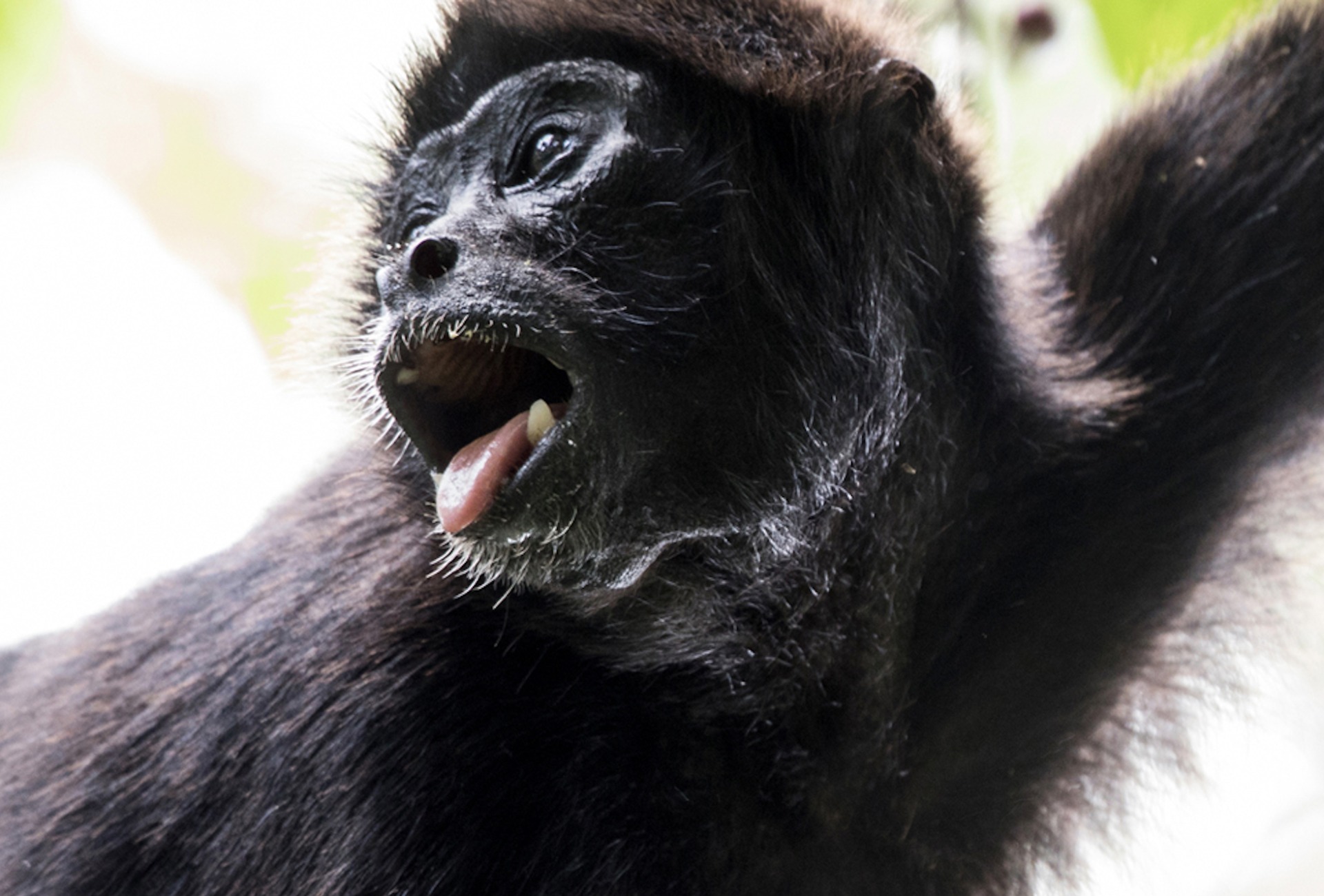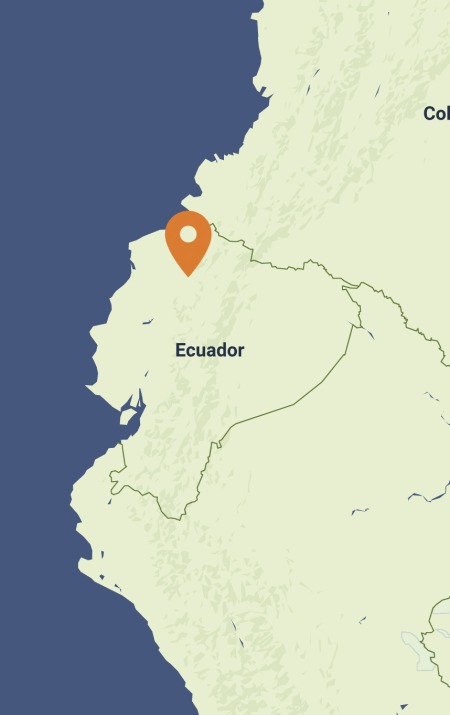
Refuge for the Brown-headed Spider Monkey
Support More Work Like ThisSupport More Work Like ThisRainforest Trust is working with Ecuadorian partner, the Cambugán Foundation to establish a core protected area of 1,729 acres in Tesoro Escondido through land purchase to protect vital habitat for the Ecuadorian Brown-headed Spider Monkey.
-
Species at Risk
Ecuadorian Brown-headed Spider Monkey (CR), Great-green Macaw (EN), Baudo Guan (EN), Banded Ground-cuckoo (EN), Long-wattled Umbrellabird (VU), Jaguar (NT)
-
Carbon stored
(Not Calculated)*
*(metric tons of CO2 equivalents) -
Partner
Cambugán Foundation
-
1,517 Proposed Acres Conserved by
Designated
-
Project Cost: $220,000

1,517
Rainforest Trust is working with Ecuadorian partner, the Cambugán Foundation to establish a core protected area of 1,729 acres in Tesoro Escondido through land purchase to protect vital habitat for the Ecuadorian Brown-headed Spider Monkey.
-
Species at Risk
Ecuadorian Brown-headed Spider Monkey (CR), Great-green Macaw (EN), Baudo Guan (EN), Banded Ground-cuckoo (EN), Long-wattled Umbrellabird (VU), Jaguar (NT)
-
Carbon stored
(Not Calculated)*
*(metric tons of CO2 equivalents) -
Partner
Cambugán Foundation
-
1,517 Proposed Acres Conserved by
Designated
-
Project Cost: £165,413

1,517
The critically endangered Ecuadorian brown-headed Spider Monkey is one of the rarest primates in the world. The global population of the species is estimated at around 250 individuals. Found only in Ecuador’s Chocóan rainforests, these endangered primates are threatened by loss of their forest habitat, hunting and expanding oil palm pressures that threaten their very survival.
An estimated population of 150 Ecuadorian Brown-headed Spider Monkeys, one of the largest remaining populations, exists in the region of Tesoro Escondido in northwestern Ecuador. This site is a global priority for the species, as well as a region of exceptional biodiversity home to Great-green Macaws, Jaguars and many other species.
Rainforest Trust is working with Ecuadorian partner, the Cambugán Foundation to establish a core protected area of 1,729 acres in Tesoro Escondido through land purchase to protect vital habitat for the Ecuadorian Brown-headed Spider Monkey. Furthermore, an innovative and sustainable chocolate project will be established in the buffer zone of the new reserve allowing cacao producers to protect forests and gain fair trade prices from quality chocolate markets.
We would like to thank the Scott Rasmussen Family Trust and the University of Sussex for their donation to support the purchase of habitat that will protect the Critically Endangered Ecuadorian Brown-headed Spider Monkey.
Explore Ecuador

Endangered Great Green Macaw courtesy of Martin Mecnarowski

Banded Ground Cuckoo, by Agami Photo Agency

The Critically Endangered Brown-headed spider Monkey courtesy of James Muchmore
Biodiversity
Tesoro Escondido encompasses one of the last remnants of the Chocó lowland rainforest in Ecuador, a hotspot for biodiversity possessing one of the highest concentrations of endemic and threatened species in the world.
The Ecuadorian Brown-headed Spider Monkey, a species endemic to this region, has been identified as one of the 25 most endangered primates in the world. The spider monkey plays a critical role in maintaining forest diversity as a key species in seed dispersal for numerous tree species. Tesoro Escondido is the global stronghold for the species. In addition to being a stronghold for the Ecuadorian Brown-headed Spider Monkey. Tesoro Escondido is home to one of the last populations of western Ecuadorian jaguars and 44% of mammal species recorded in Ecuador. Though further surveys are needed, a variety of endangered frogs and reptiles have also been discovered to inhabit this area. A variety of endangered or range restricted bird species are also found within Tesoro Escondido. Several globally threatened birds have been observed here including species such as the Great-green Macaw, Baudo Guan, Banded Ground-cuckoo and Long-wattled Umbrellabird (VU).
Challenges
With the highest rates of deforestation in South America, Ecuador is facing a major challenge. Action is particularly urgent in areas with remnants of primary forests, such as those found in the province of Esmeraldas in Northwestern Ecuador.
These forests represent one of 25 global biodiversity hotspots identified for urgent conservation action by scientists due to the high number of species they contain and the level of threat they face. No more than 50 years ago these forests were considered to be in the best condition of all the Ecuadorian coastal forest habitats. The forest at Tesoro Escondido is a remnant of these primary forests. At present, the forests of Tesoro Escondido remain at risk due to rapid land development and increased demand for timber, agricultural products and oil palm. Urgent action is needed to protect this wildlife refuge and to search for economic alternatives for the local people that combine wildlife conservation and sustainable incomes.
Communities
Local people around Tesoro Escondido are principally farmers, focusing especially on cacao.
The buffer zone is currently protected in part through a sustainable chocolate project where world class chocolate is produced by farmers in the Tesoro Escondido community and then professionally processed to ensure top prices from quality chocolate producers. The farmers agree to avoid deforestation and engage in regeneration of native forest on their lands. This is monitored using drone technology by the University of Sussex. This innovative partnership is already helping reduce pressures on forests by linking higher prices directly to conservation and forest restoration goals for sustainable development.
Solutions
The new Tesoro Escondido Reserve is vital for protecting and expanding the last stronghold for the Critically Endangered Ecuadorian Brown-headed Spider Monkey.
Experience over the years with the Tesoro community has shown that involving local families in the decision-making of the objectives, organization and logistics of research projects positively affects attitudes towards the forests and towards visiting researchers, creating a genuine interest and a sense of empowerment that ultimately leads to a common decision to conserve the forests. Therefore the University of Sussex and Cambugán Foundation are establishing a community-run ‘Research Hub’, which allows students and researchers to live in the homes of host families for short stays, and gives them access to a community space and forest research station. This concept differs from the traditional concept of a research station built and managed by external stakeholders, which can alienate the community and separate local people from the research and its objectives. The reserve is also implementing a “parabiologist” program, in which local people are trained and hired to work as research assistants, actively involved in the research carried out in the reserve, receiving full credit in publications, symposiums, etc. The parabiologist training program provides an alternative source of income directly linked to conservation for young people in Tesoro who often have little option but to migrate to cities or to work for the local timber company. By paying parabiologists a competitive wage and building a fair price structure for the Tesoro Research Hub, we aim to help local communities develop a sustainable livelihood over the long-term.

We Value Transparency.
Conservation work is critical, challenging, and can be costly. We work hard to ensure we raise only the funds needed for each project. In the rare case we raise more money than needed or a project comes in under budget, excess monies will be transferred to the Conservation Action Fund. This fund supports our important conservation work throughout the tropics.
Learn more about the Conservation Action FundLearn more about the Conservation Action Fund

Strategic Land Purchase to Expand Habitat Protection in the Chocó of Ecuador


Partnering to Save Rainforest
Our partners’ ability to work with their governments and build strong connections with local communities ensures the successful implementation of our projects.
Learn More About This PartnerLearn More About This Partner
